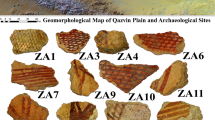Abstract
The phase transformations as a function of the temperature of two natural illitic clays were investigated through XRD measurements, ex situ at room temperature with conventional set up and in situ with synchrotron radiation, in order to understand the origin of the corundum phase, which is one of the main characteristics of the red glaze (slip) of Terra Sigillata from south Gaul. These clays were chosen on the basis of their chemical composition and for the quality of vitrification in the firing temperature range of sigillata (1030–1080 °C). Results show that corundum can be formed above 1000 °C if the amount of Mg is not too high. The corundum formation does not result directly from the total decomposition of illite (<900 °C) but from the formation and disruption of an intermediate potassium aluminum silicate phase. On the other hand, if chlorite is present in the raw clay so that the amount of Mg>3–4 wt. %, this intermediate phase is not observed and only a spinel phase is formed.
Similar content being viewed by others
References
Céramiques de la Graufesenque et autres productions d’époque romaine, nouvelles recherches, hommages à Bettina Hoffmann, Vol. 7 (dir M. Genin, A. Vernhet, ed monique mergoil, Montagnac, 2002)
La difusiò de la terra sigillata sud Gàllica al nord d’Hispania, Monografies del CASC 6 (dir. X. Nieto, M. Roca Roumens, A. Verhnet, P. Sciau, ed. MAC-Barcelona, 2005)
M. Picon, Rev. Archeo. 21, 86 (1997)
P. Mirti, L. Appolonia, A. Casoli, J. Archaeol. Sci. 26, 1427 (1999)
P. Sciau, M.A. Languille, E. Dooryhee, T. Martin, A. Vernhet, in UnderstandingPeopleTroughTheirPottery, Proc. 7th European Meeting on Ancient Ceramics, EMAC’03 (IPA—Archaeological Portuguese Institute, Lisboa, 2005) pp. 243
P. Sciau, S. Relaix, C. Roucau, Y. Kihn, D. Chabanne, J. Am. Ceram. Soc. 89, 10531 (2006)
C.C. Tang, E.J. MacLean, M.A. Roberts, D.T. Clarke, E. Pantos, A.J.N. Prag, J. Archaeol. Sci. 28, 1015 (2001)
T. Pradell, J. Molera, E. Pantos, A.D. Smith, C.M. Martin, A. Labrador, Appl. Phys. A (2007) (in this volume)
R.E. Grim, W.F. Bradley, J. Am. Ceram. Soc. 23, 242 (1940)
C.J. McConville, W.E. Lee, J. Am. Ceram. Soc. 88, 2267 (2005)
H. Keppler, Am. Mineral. 75, 529 (1990)
C.J. McConville, W.E. Lee, J.H. Sharp, Brit. Ceram. Trans. J. 97, 162 (1998)
Author information
Authors and Affiliations
Corresponding author
Additional information
PACS
61.10.Nz; 07.85.Qe
Rights and permissions
About this article
Cite this article
Sciau, P., Relaix, S., Mirguet, C. et al. Synchrotron X-ray diffraction study of phase transformations in illitic clays to extract information on sigillata manufacturing processes. Appl. Phys. A 90, 61–66 (2008). https://doi.org/10.1007/s00339-007-4249-5
Received:
Accepted:
Published:
Issue Date:
DOI: https://doi.org/10.1007/s00339-007-4249-5



